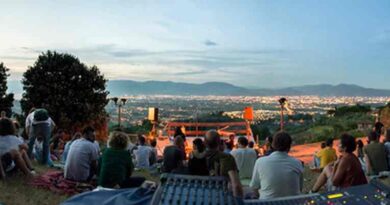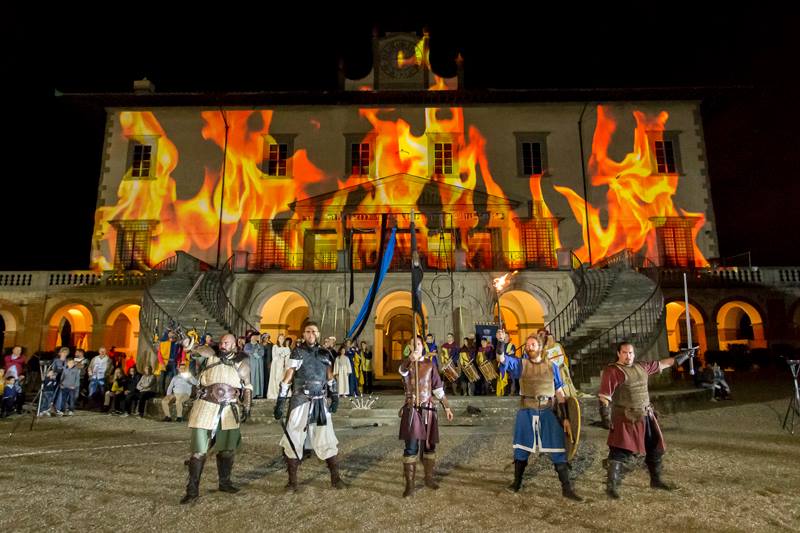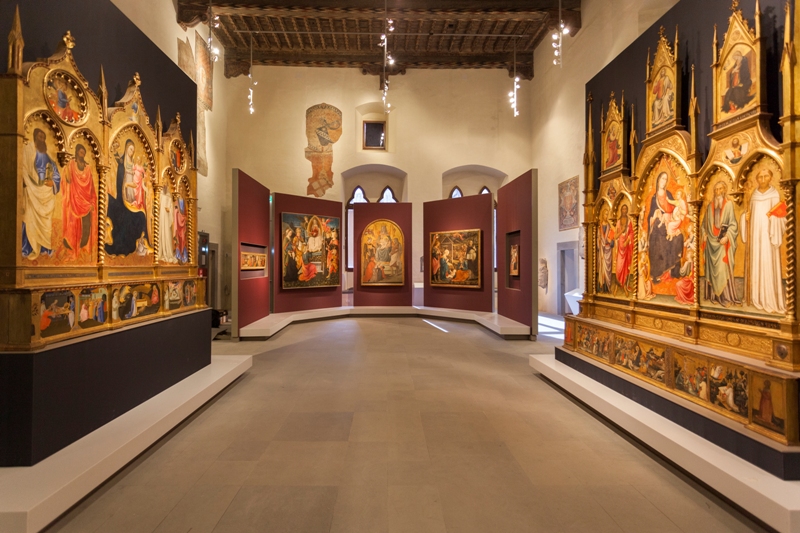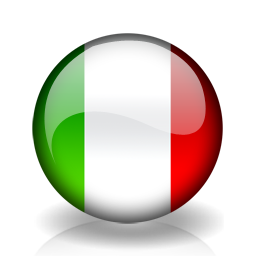For golf enthusiasts, the renowned and highly appreciated 18-hole course, 'Le Pavoniere Golf & Country Club' is a short distance from the hotel, and is the perfect place to have fun in nature.
Located close to Carmignano and the medieval village of Artimino, in a few minutes you can reach some of the best and historic wine cellars, producers of Chianti IGT wine and extra virgin olive oil of Montalbano.
The "Strada dell'olio e del vino del Montalbano"
A scenic route in Tuscany, Italy, that winds through the rolling hills of the Montalbano region. The route is known for its picturesque vineyards and olive groves, as well as for the small towns and villages that dot the landscape. Along the way, visitors can stop at local wineries and olive oil mills to sample the delicious local products and learn about the traditional methods used to produce them. This route is also known as the Colline di Leonardo because it runs through the hills of the Montalbano region, which is said to have inspired the famous Renaissance artist Leonardo da Vinci.Experiences and Activities
Local Events
Festival delle Colline
is home to one of the most important Italian contemporary music festivals: "The Hill Festival", founded in 1976 as "Giugno Poggese" with a more "traditional" programming (dance shows, chamber concerts, or high-level soloists), the Festival has since assumed its current name and, since 1990, has tried to carve out its own space by focusing on contemporary music, thus attracting international interest and bringing the name of Poggio a Caiano to the headlines of many foreign newspapers.

With a 20-year history, the festival sees the active involvement of some of the most important institutions in the Province of Prato. Promoted as always by the Municipality of Poggio a Caiano with the collaboration of the Tuscany Region, the Luigi Pecci Contemporary Art Center, the Municipality of Prato and other municipalities in the area, the Festival dedicates some of its most important events not only to classic examples of world music, but also to artists who, although referring to popular materials, no longer elaborate their texts and melodies exclusively in an ethnic sense.
It is worth noting that the shows take place in some of the most prestigious places in the province of Prato: from the modern Amphitheater of the Luigi Pecci Contemporary Art Center to the beautiful park of the Villa Medicea of Poggio a Caiano, from the Villa Novellucci of Cantagallo to the "Quinto Martini" Park Museum of Carmignano. The Festival has presented in its most recent editions not only some of the best examples of current musical research, with a particular attention to the ethnic roots of "Global Music", but also refers to the concept of global culture in which the various languages of the show interweave and complement each other, trying to give a snapshot of what is the contemporaneity of the arts.
Assedio alla Villa
The Siege of the Villa has now become an annual event that attracts thousands of visitors, not only from the Prato area, to participate in the numerous initiatives that are part of the program defined by the organizing committee.
The Siege Festival showcases our "historic center" around the Villa and the Stables (where the usual exhibition of Poggesi artisans on "Crafts as Art" will take place), recently enriched by new multipurpose spaces and the important Museum entirely dedicated to Ardengo Soffici.

Also in this edition of the Siege of the Villa, which now constitutes a significant point of reference for the end-of-summer festivals at the regional level, there will be spaces and moments of recreation and entertainment, enriched by the presence of the Poggesi Associations' food stands, with the presence of antique stalls, spaces dedicated to arts and ancient crafts, with musical and theatrical events,
With the important parade in which historical characters are represented with their beautiful period costumes specially made by the Poggese Historical Group with an accurate and attentive study of the original clothes of the Medici period.
And then, in addition to the now traditional and evocative "Renaissance dinner" in the beautiful setting of the Villa Medicea, the initiative of the re-enactment of the journey by carriage that the princess Giovanna of Austria made from Innsbruck to Florence for her wedding to Prince Francesco de' Medici will be repeated.
The journey of the vintage carriage, which will arrive in Poggio a Caiano, includes stops in the major cities of the route and this initiative will certainly help to make the history of the Medici, of the Villa Ambra and therefore of the city of Poggio a Caiano, even more known at the national level.
Experiences e tours
Palazzo Petrorio Museum
Stern and imposing, Palazzo Pretorio dominates the Piazza del Comune of Prato, a silent witness to the political, civil and military events of the city for more than seven hundred years. Today, its appearance tells us about its long and troubled history, through the alternation of architectural styles and the continuous remodeling of its structure.
The Palace was built at the end of the 13th century as a municipal seat for the court, the prisons, and the foreign magistracies. Its soul changes radically in the 18th century, when the halls of the building become administrative offices of the Grand Duchy of Tuscany, adapting to the needs of a modern state. In the mid-19th century, the government offices move and the Palace is abandoned to total neglect, even risking being demolished.

Fortunately, a long restoration is preferred, which lasts until the 1920s, when the external stone staircase is rebuilt and the facade takes on its current appearance. Meanwhile, in 1912, the new Museum headquarters is inaugurated in the Palace halls. Duomo of Prato On the left of the cathedral, the small courtyard that precedes the bishop's palace gives access to the Museum of the Cathedral Works, established in 1967 in the first two halls, and expanded in 1976 to house works from the entire diocese and the prestigious reliefs of Donatello's pulpit.
The collection thus became a true diocesan museum. Of great beauty can be found: Room of Tapestries-Room of the 1300s-Excavation Area-Sacred Belt Room-Renaissance Room-Pulpit Room-17th century Room-Romanesque cloister-Antiquarium and "Vault"
Bike Tour From
S. Lucia to via Protche Starting from S. Lucia, the bike path runs between the olive garden and the sidewalk of v.le Galilei. It continues by passing under the Datini bridge and arrives at via Protche (crossing the Datini bridge, you can enter the Vaiano - Prato track).
It is entirely paved and lit. There are rest areas provided with drinking water. In the stretch from via Protche to the gardens of v.le Galilei, it has been doubled, reserving the part closest to the river for pedestrians and the part closest to the road for bicycles.
From the gardens of v.le Montegrappa to the Lama bridge, the stretch in question is made of packed earth with scattered gravel. It also follows the course of the Bisenzio river, but at varying heights. Recommended as a day tour.
Food and Wine Tour
From Prato to Montemurlo, to Carmignano, a wide range of places to discover the different flavors of the area.
The Prato Bozza is a traditional type of bread from Prato, with peasant origins and naturally without salt.
The Prato Mortadella IGP is a sausage made of pork meats, sea salt, garlic, spices and alkermes.
The dried figs of Carmignano are among the typical products of Tuscany: they are a niche and limited cultivation, which uses non-invasive methods and in full respect of tradition.
WINE EXPERIENCE AT FATTORIA DI BACCHERETO
"Guided tour of the vineyards and cellars of the Tenuta, with a final wine tasting of Terre a Mano Wines, Extra Virgin Olive Oil and Bruschette." - Carmignano, Prato
PRIVATE WINE TASTING PICNIC AT TENUTA DI ARTIMINO
Enjoy an exclusive picnic in the Tuscan countryside with a tasting of 4 wines and some seasonal local dishes in a beautiful picnic basket." - Carmignano, Prato
DISCOVER OUR SEASONAL OFFERS
Discover All Offers



